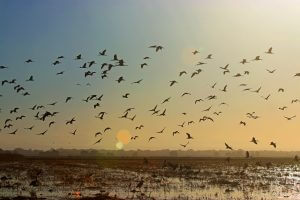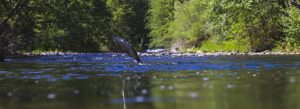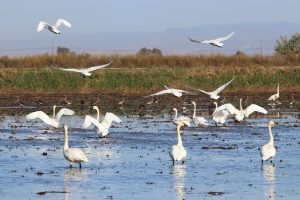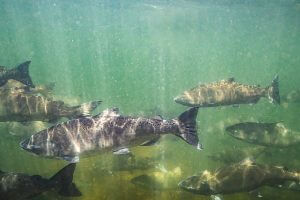By Todd Manley
As 2021 was shaping into the most challenging water year in recent history—with the driest and hottest conditions anyone could remember–water resources managers in the Sacramento Valley developed a “roadmap” in May, outlining plans to maximize habitat for fish in wildlife with the minimal water resources that were available. At that time, water managers in every part of the Valley knew they were going to see substantial reductions in their water supplies and they were developing and implementing drought plans to manage the limited supplies available. Now, we have an opportunity to look back at this challenging year and evaluate the actions that were taken to determine the value they provided to fish and wildlife in the region and what we can learn for future dry years.

Birds and the Pacific Flyway
The drought and pressure to hold more water in the reservoirs created a substantial decrease in irrigated Pacific Flyway habitat in 2021. Level 2 Refuge water supplies were cut by 25 percent and around 150,000 acres of rice, which provides a majority of the food for waterfowl in the Sacramento Valley, were fallowed. Water managers and Refuge managers coordinated actions to provide as much habitat in the Valley as possible with the extremely limited water supplies available. Following the Governor’s Executive Order, landowners and conservation organizations implemented an incentive program to use groundwater to irrigate habitat in the fall, when very little habitat was available in the region. This program, the October rains, and timely lifting of Term 91 by the State Water Resources Control Board to allow for surface water deliveries once there was adequate water in the region’s waterways, provided important Pacific Flyway habitat in the region, which avoided significant bird deaths from disease or other drought-related causes.
In 2021, we learned that we cannot assume that there will be surface water supplies in the fall and early winter months during drought years to irrigate Pacific Flyway habitat. Increased carryover storage requirements and limitations on surface water deliveries will further impact the availability of these environmental supplies. In addition, the programs established to provide incentives to flood up habitat using groundwater can provide limited, but very valuable acres of habitat to help the flyway species and need to be included in future drought planning efforts, particularly as a bridge to the rains that typically come in the winter.

Salmon
Water resources managers in the Sacramento Valley implemented voluntary actions to improve the quantity and timing of flows in the Sacramento River to improve habitat for winter-run Chinook salmon. These actions were especially important this year, as there was a substantial return of adult winter-run and the Valley temperatures were exceptionally hot.
Even in the midst of the drought year, work continued to advance projects to provide benefits to all runs of salmon, in all reaches of the Valley’s rivers to provide benefits for all freshwater life-cycle stages. Projects completed in 2021 included: Nur Pon (formerly South Cypress Island Side Channel Restoration Project) on the Sacramento River, Ancil Hoffman Habitat Restoration Project on the American River, Hallwood Floodplain and Side Channel Restoration Project on the Yuba River and the Knights Landing Outfall Gates Fix on the Sacramento River. These projects were building on many previous projects that have been implemented in the Sacramento Valley since 2000.
Importantly, fish were observed in 2021 in the rivers using the many habitat projects that have been implemented since the last drought. These projects likely contributed to the improved survival of the species compared to the last drought year in 2015. For the endangered winter-run Chinook that spawn in the Sacramento River, the monitoring in 2021 revealed much better results than the “total loss” of the run that was predicted by many in the spring. To summarize,
- It is estimated by CDFW that 10,269 adult winter-run Chinook salmon returned to the Sacramento River to spawn. This is the largest number of returning adults based on California Department of Fish and Wildlife (CDFW) carcass counts1 in the last 15 years and shows a positive trend with similar returns of 8,128 in 2019 and 7,428 in 2020. (These estimates are based on the carcass recapture study which found 4,847 actual carcasses this year.)
- According to the CDFW, approximately 75% of these in-river spawners (actual carcasses found) were natural-origin winter-run Chinook (not hatchery returns).
- Fry and juvenile salmon have been observed utilizing rearing habitat, including side channels constructed since the last drought (see e.g., Nur Pon Side Channel video).
- Amazingly, this returning class is the second-generation descendants of salmon from 2015, the last very dry year when many commentators proclaimed a complete loss of winter-run salmon; as well as 2018, which was a relatively wet year.
- More than 559,801 juvenile winter-run Chinook salmon have already (as of December 16) begun their journey downstream past the city of Red Bluff, 60 miles downstream from their spawning grounds. The number of fish estimated to have passed Red Bluff during this incredibly dry year already have surpassed the number of estimated out-migrants in 2015 (the last drought year) by more than 220,000.
- Importantly, during the large storm that hit the region, the screw-traps in Red Bluff that are used to measure the out-migrating juveniles were raised and did not collect fish for two days (October 25 and 26). They also did not collect fish on November 25 and 26 due to the Thanksgiving holiday.
- This extremely difficult year for winter-run follows three years with substantially better juvenile out-migrant estimates – 1,168,270 fish in 2018, 3,813,580 fish in 2019 and 2,096,219 in 2020.
- The substantial 2019 juvenile out-migration (3,813,580 fish) are the next generation of the 2016 run, which produced an estimated 537,520 juvenile outmigrants, which is 15,000 fewer fish than have already passed by Red Bluff this year.


In 2021, we learned that even in the most severe dry years salmon will take advantage of the flows and habitat provided to them and, rather than wasting energy dwelling on doom and gloom scenarios, we should instead go to work with our partners and make the investments to improve conditions for salmon in the rivers and floodplains, creating much-needed benefits for Chinook salmon in the worst water years, and increasing species survival.
Dry years and prolonged drought are increasingly likely as we experience the effects of climate change. Learning from past dry years and implementing drought programs and habitat improvements to provide the most benefits for fish and wildlife with the limited water supplies available will hopefully soften the impacts of drought in the future. This year we learned the value of early planning; the importance of collaboration with state and federal agencies, conservation partners, and landowners; and the importance of the robust recovery programs underway in the Sacramento Valley for birds, salmon and Giant Garter Snakes, which seem to be providing value in these dry years.
Water managers in the Sacramento Valley will continue to work with various partners to refine and improve their drought programs to better provide water for all beneficial uses in the region in dry years to come. If you have any additional suggestions to help the region better prepare for future dry years, please let us know at info@norcalwater.org.
1California Department of Fish and Wildlife monitoring found 4,849 winter-run Chinook carcasses in the Sacramento River spawning grounds this year, which is the largest count in fifteen years. Importantly, observed carcasses are used to model and expand to an estimate of the total number of adult fish that successfully migrated to the spawning grounds. The estimated total returning fish is substantially greater than those counted. For example, in 2020, the carcass count was 3,678 fish and the final estimated return was nearly doubled to 7,428 fish and in 2019, the count of 3,026 fish was more than doubled to a final estimate of 8,128 fish. In addition, the carcass monitoring this year counted 1,588 female winter-run Chinook that had spawned before dying. This was also the largest number counted in fifteen years. (See California Department of Fish and Wildlife 2021 Winter-run Chinook Update File, “ALL YEAR SUMMARY by date” tab (available here). California Department of Fish and Wildlife “California Central Valley Chinook Population Database Report” (Grand Tab 2021.06.30); California Department of Fish and Wildlife 2021 Winter-run Chinook Update File, “Fresh spawn Female by week-year” tab (available here).




You must have overlooked this sobering statistic .
“State officials confirmed dire predictions of catastrophic fish kills due to sizzling water temperatures in California’s largest river, announcing Thursday that just 2% of winter-run Chinook juvenile salmon likely survived the summer.”
So this is three out of the last seven years of water temperature die off of over 80% of these listed Endangered Salmon.
Who is the steward of these fish?
https://www.redding.com/story/news/2022/01/04/warm-water-leads-thousands-salmon-deaths-sacramento-river/9086069002/ This Redding newspaper reports “Warm water leads to thousands of salmon deaths in the Sacramento River” While you report deaths of salmon that have spawned, the Record reports that ” nearly the entire hatch of endangered winter-run chinook salmon were wiped out in 2021 due in part to high water temperatures in the Sacramento River in the Redding area.” The water was released to be delivered to farms at such a high temperature that the steelhead fry died. Your report is completely optimistic and says nothing about steelhead fry, but a lot about the successes of the new habitat and management during 2021. Another example of “sides” having a different reality. If you agree that the steelhead fry could not survive in the warm water release, you should have pointed that out too. Or addressed it if you don’t agree.